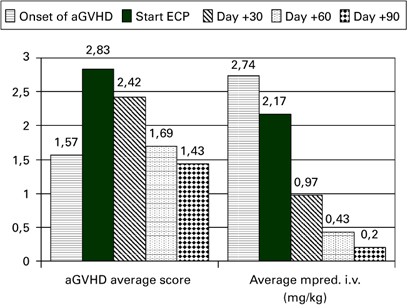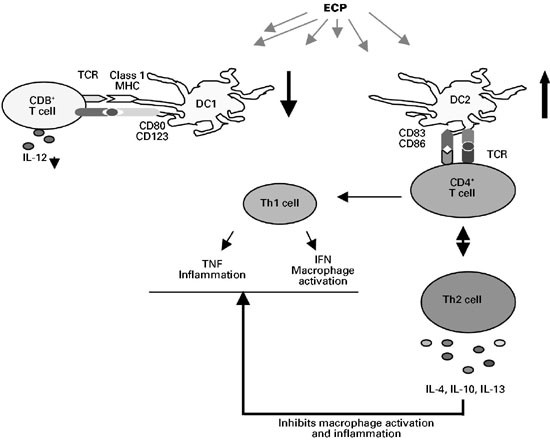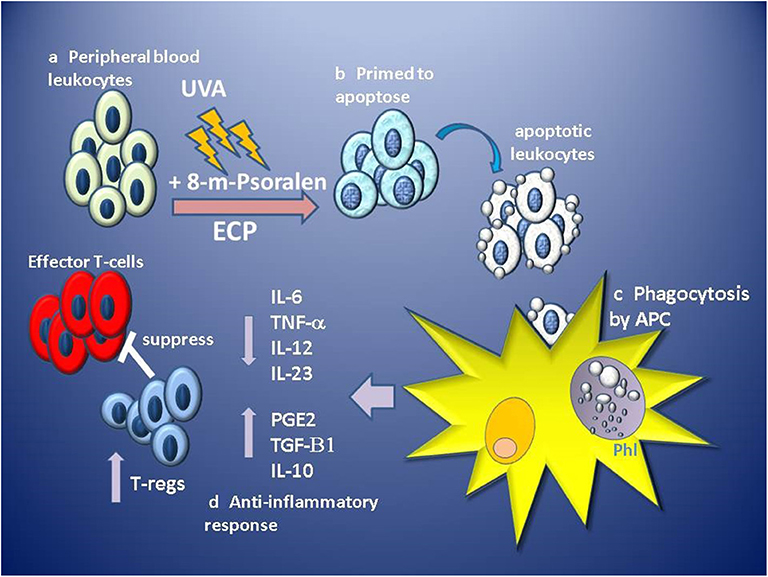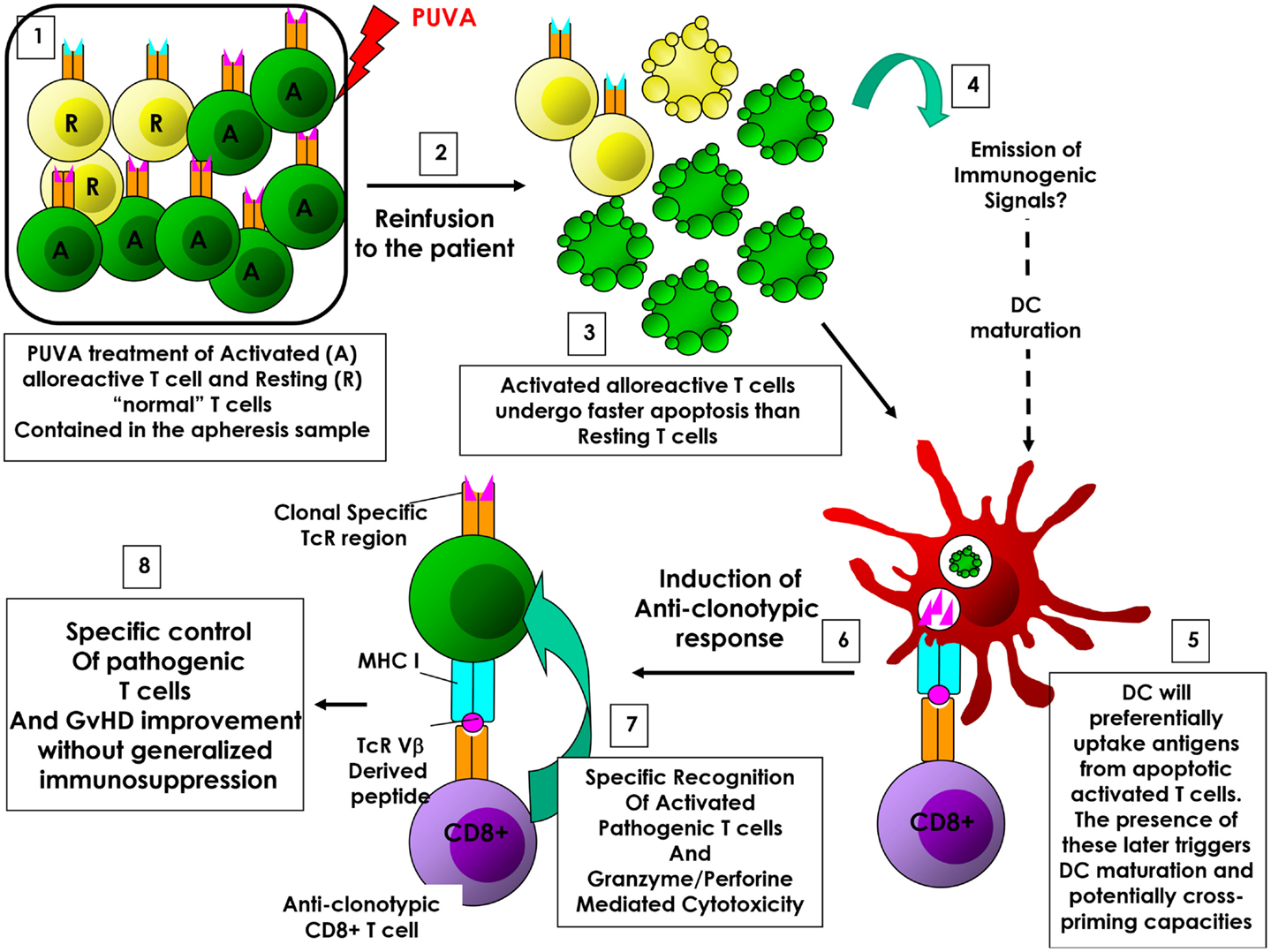The optimal therapy for steroid-refractory SR acute graft-versus-host disease aGVHD is undefined. SIDE EFFECTS OF UVADEX.
 Extracorporeal Photopheresis In Prevention And Treatment Of Acute Gvhd Sciencedirect
Extracorporeal Photopheresis In Prevention And Treatment Of Acute Gvhd Sciencedirect
Extracorporeal photopheresis ECP has been used for over 20 years to treat acute GVHD aGVHD and chronic GVHD.

Photopheresis treatment for gvhd. Until the use of photopheresis the only treatments that were effective to any degree have been immunosuppressive treatments. First-line treatment with steroids will be refractory in approximately half of patients with acute GVHD aGVHD. Side effects of UVADEX used with the THERAKOS Photopheresis Systems are mainly related to low blood pressure.
ECP is also called extracorporeal photopheresis. It is touted as one of the least toxic and least invasive treatment strategies available for GvHD. ECP is also used to treat solid organ transplant rejection.
9 rânduri Extracorporeal photopheresis ECP is one of the most used and established therapies for. Ioanna Sakellari et al. It is also known by the name Extra-corporeal Photopheresis or abbreviated as ECP or just called photo or light therapy.
This stops the donated cells graft from attacking your body host. N 57 and anticytokine therapy n 41. Graft-versus-host disease can range.
In multivariate analyses ECP adjusted for steroid dose odds ratio 342. Photopheresis is currently indicated and Food and Drug Administrationapproved for the treatment of skin manifestations of cutaneous T-cell lymphoma where the response rate has proved to be considerably high 8 9 10. Extracorporeal photopheresis treatment for chronic graft-versus-host disease after haematopoietic stem cell transplantation in paediatric patients Background Chronic graft-versus-host disease is a common complication after haematopoietic stem cell transplantation HSCT.
We studied patients with SR aGVHD comparing extracorporeal photopheresis ECP. One of the ways GVHD is treated is by giving the patient strong immune-suppressive medications. From George Papanikolaou Hospital Thessaloniki Greece prospectively evaluated the.
When those medications have unwanted side effects or fail photopheresis may be a next step doctors will try. Extracorporeal photopheresis ECP is commonly used either in combination with infliximab or monotherapy as second- or third-line therapy for patients with graft-versus-host disease GvHD who are dependent or refractory to steroids. Extracorporeal photochemotherapy has been evaluated in small cohorts of patients with both acute and chronic GVHD.
Listing a study does not mean it has been evaluated by the US. P 007 and grade II aGVHD odds ratio 68. Extracorporeal photopheresis ECP is a cutting-edge nonsurgical procedure to treat graft-versus-host disease GVHD a complication of bone marrow and stem cell transplants and other autoimmune disorders in children.
Extracorporeal photopheresis ECP is a second-line treatment for GVHD that involves extracting white blood cells treating them with UV light and medicine and then re-injecting them into the patient. Extracorporeal photopheresis ECP is an immunomodulatory therapy for which cutaneous T cell lymphoma is currently the only FDA-approved indication. Mortality rates in these patients are high.
It is however increasingly used as a second-line therapy for acute and chronic GVHD patients who are steroid-refractory or -dependent. The process is very similar to how stem cells are collected for donation. Photopheresis for the Treatment of Acute Graft Versus Host Disease The safety and scientific validity of this study is the responsibility of the study sponsor and investigators.
Treatments for GvHD further increase this risk. Evidence on the efficacy of response in aGVHD has continued to accrue and data suggest that there is a good response and prolonged survival in both children and adults with grade II-IV aG. Traditional prevention and treatment strategies have focused on reducing alloreactivity typically with therapy to reduce cytotoxic T-cell function.
In medicine Photopheresis is a medical treatment process used to treat a variety of diseases one of which is GvHD. Photopheresis is another way to treat the disease in a more gentle way Dr. Emerging evidence exists that promotion of regularly T-cell function through treatments such as extracorporeal photopheresis is effective for GVHD treatment and has potential for prevention as well.
The use of UVADEX for the treatment of GVHD is not approved by the FDA. Most of these drugs work by damping down suppressing your immune system. 1 In addition next-line therapies although numerous are not standardized and are accompanied by several complications including profound immunosuppression end-organ damage risk for secondary.
For the THERAKOS UVAR XTSCELLEX Photopheresis Systems procedure. Transplant of blood-forming stem cells. Safety of UVADEX in children has not been shown.
You are at a greater risk of getting an infection if you have GvHD because it weakens your immune system. Extracorporeal photopheresis ECP a technique recently proposed in chronic GVHD is promising and is believed to attack the actual cause of the disease the role of cytotoxic T lymphocytes is now recognized. ECP is a treatment for GvHD which is designed to destroy the T cells and white blood cells which cause the GvHD.
 Treatment Of Acute Graft Versus Host Disease In Childhood With Extracorporeal Photochemotherapy Photopheresis The Padova Experience Biology Of Blood And Marrow Transplantation
Treatment Of Acute Graft Versus Host Disease In Childhood With Extracorporeal Photochemotherapy Photopheresis The Padova Experience Biology Of Blood And Marrow Transplantation
 Response To Ecp After 3 Months Of Treatment According To Type Of Gvhd Download Table
Response To Ecp After 3 Months Of Treatment According To Type Of Gvhd Download Table
 Extracorporeal Photopheresis For The Treatment Of Steroid Refractory Acute Gvhd Bone Marrow Transplantation
Extracorporeal Photopheresis For The Treatment Of Steroid Refractory Acute Gvhd Bone Marrow Transplantation
 Extracorporeal Photopheresis After Heart Transplantation Immunotherapy
Extracorporeal Photopheresis After Heart Transplantation Immunotherapy
 Extracoporeal Photopheresis Treatment Of Acute F1000research
Extracoporeal Photopheresis Treatment Of Acute F1000research
 Figure 3 From Extracorporeal Photopheresis A Review On The Immunological Aspects And Clinical Applications Semantic Scholar
Figure 3 From Extracorporeal Photopheresis A Review On The Immunological Aspects And Clinical Applications Semantic Scholar
 Pdf Extracorporeal Photopheresis Ecp For Treatement Of Acute And Chronic Graft Versus Host Disease An Italian Multicentric Retrospective Analysis On 94 Patients On Behalf Of The Gruppo Italiano Trapianto Di Midollo Osseo
Pdf Extracorporeal Photopheresis Ecp For Treatement Of Acute And Chronic Graft Versus Host Disease An Italian Multicentric Retrospective Analysis On 94 Patients On Behalf Of The Gruppo Italiano Trapianto Di Midollo Osseo
 Extracorporeal Photopheresis For Colitis Induced By Checkpoint Inhibitor Therapy Nejm
Extracorporeal Photopheresis For Colitis Induced By Checkpoint Inhibitor Therapy Nejm
 Extracorporeal Photopheresis In Chronic Graft Versus Host Disease Bone Marrow Transplantation
Extracorporeal Photopheresis In Chronic Graft Versus Host Disease Bone Marrow Transplantation
 Update On The Mechanism Of Action And On Clinical Efficacy Of Extracorporeal Photopheresis In The Treatment Of Acute And Chronic Graft Versus Host Disease In Children Transfusion And Apheresis Science
Update On The Mechanism Of Action And On Clinical Efficacy Of Extracorporeal Photopheresis In The Treatment Of Acute And Chronic Graft Versus Host Disease In Children Transfusion And Apheresis Science
Modified Extracorporeal Photopheresis With Cells From A Healthy Donor For Acute Graft Versus Host Disease In A Mouse Model
 Frontiers Extracorporeal Photopheresis Ecp And The Potential Of Novel Biomarkers In Optimizing Management Of Acute And Chronic Graft Vs Host Disease Gvhd Immunology
Frontiers Extracorporeal Photopheresis Ecp And The Potential Of Novel Biomarkers In Optimizing Management Of Acute And Chronic Graft Vs Host Disease Gvhd Immunology
 Management Of Acute Graft Versus Host Disease
Management Of Acute Graft Versus Host Disease
 Frontiers Extracorporeal Photopheresis Tolerogenic Or Immunogenic Cell Death Beyond Current Dogma Immunology
Frontiers Extracorporeal Photopheresis Tolerogenic Or Immunogenic Cell Death Beyond Current Dogma Immunology

No comments:
Post a Comment
Note: Only a member of this blog may post a comment.